sensor TOYOTA CAMRY 2022 Owner's Guide
[x] Cancel search | Manufacturer: TOYOTA, Model Year: 2022, Model line: CAMRY, Model: TOYOTA CAMRY 2022Pages: 664, PDF Size: 11.3 MB
Page 332 of 664
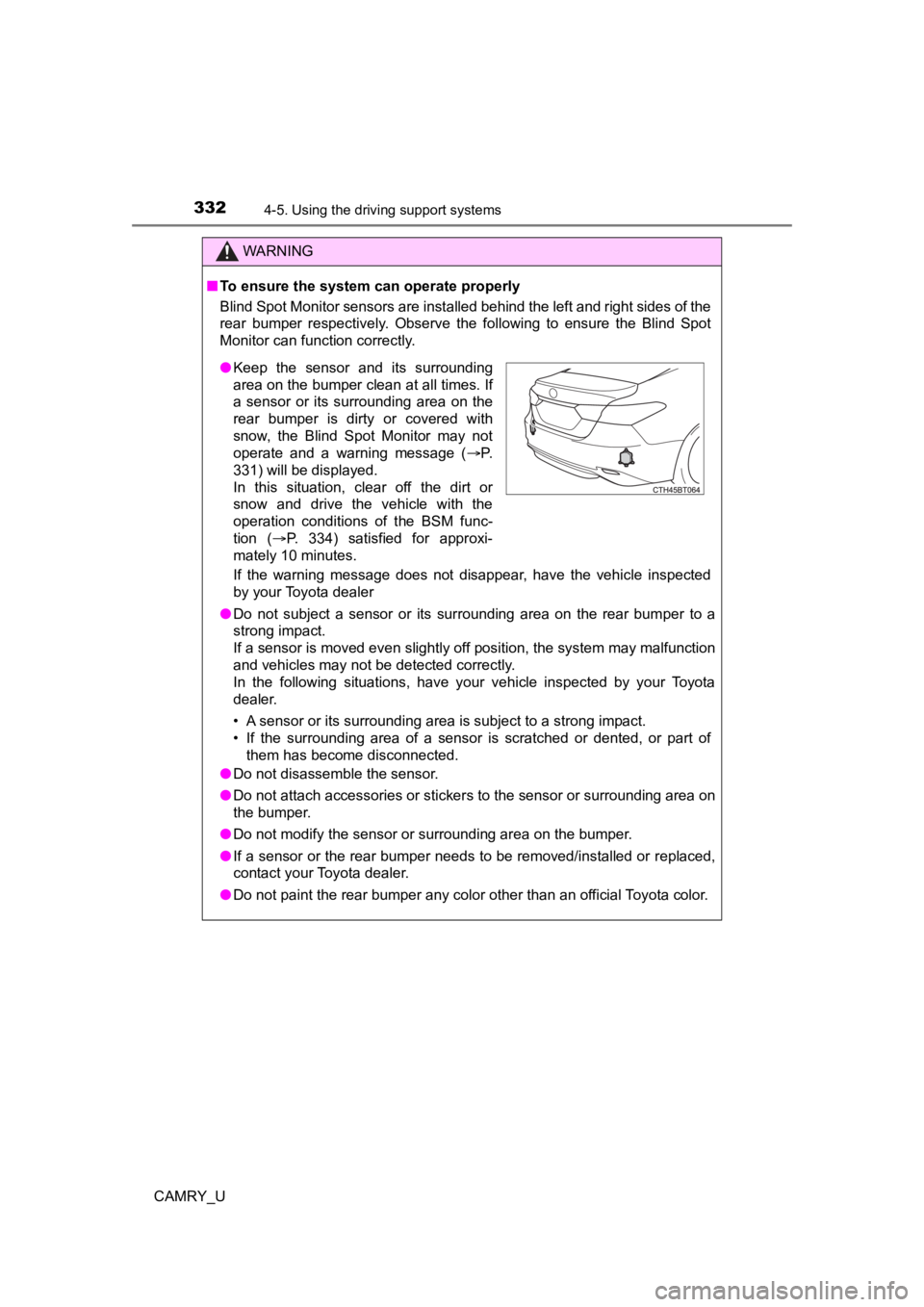
3324-5. Using the driving support systems
CAMRY_U
WARNING
■To ensure the system can operate properly
Blind Spot Monitor sensors are installed behind the left and ri ght sides of the
rear bumper respectively. Observe the following to ensure the Blind Spot
Monitor can function correctly.
If the warning message does not disappear, have the vehicle inspected
by your Toyota dealer
● Do not subject a sensor or its surrounding area on the rear bumper to a
strong impact.
If a sensor is moved even slightly off position, the system may malfunction
and vehicles may not be detected correctly.
In the following situations, have your vehicle inspected by your Toyota
dealer.
• A sensor or its surrounding area is subject to a strong impact .
• If the surrounding area of a sensor is scratched or dented, or part of them has become disconnected.
● Do not disassemble the sensor.
● Do not attach accessories or stickers to the sensor or surrounding area on
the bumper.
● Do not modify the sensor or surrounding area on the bumper.
● If a sensor or the rear bumper needs to be removed/installed or replaced,
contact your Toyota dealer.
● Do not paint the rear bumper any color other than an official Toyota color.
●Keep the sensor and its surrounding
area on the bumper clean at all times. If
a sensor or its surrounding area on the
rear bumper is dirty or covered with
snow, the Blind Spot Monitor may not
operate and a warning message ( P.
331) will be displayed.
In this situation, clear off the dirt or
snow and drive the vehicle with the
operation conditions of the BSM func-
tion ( P. 334) satisfied for approxi-
mately 10 minutes.
Page 333 of 664
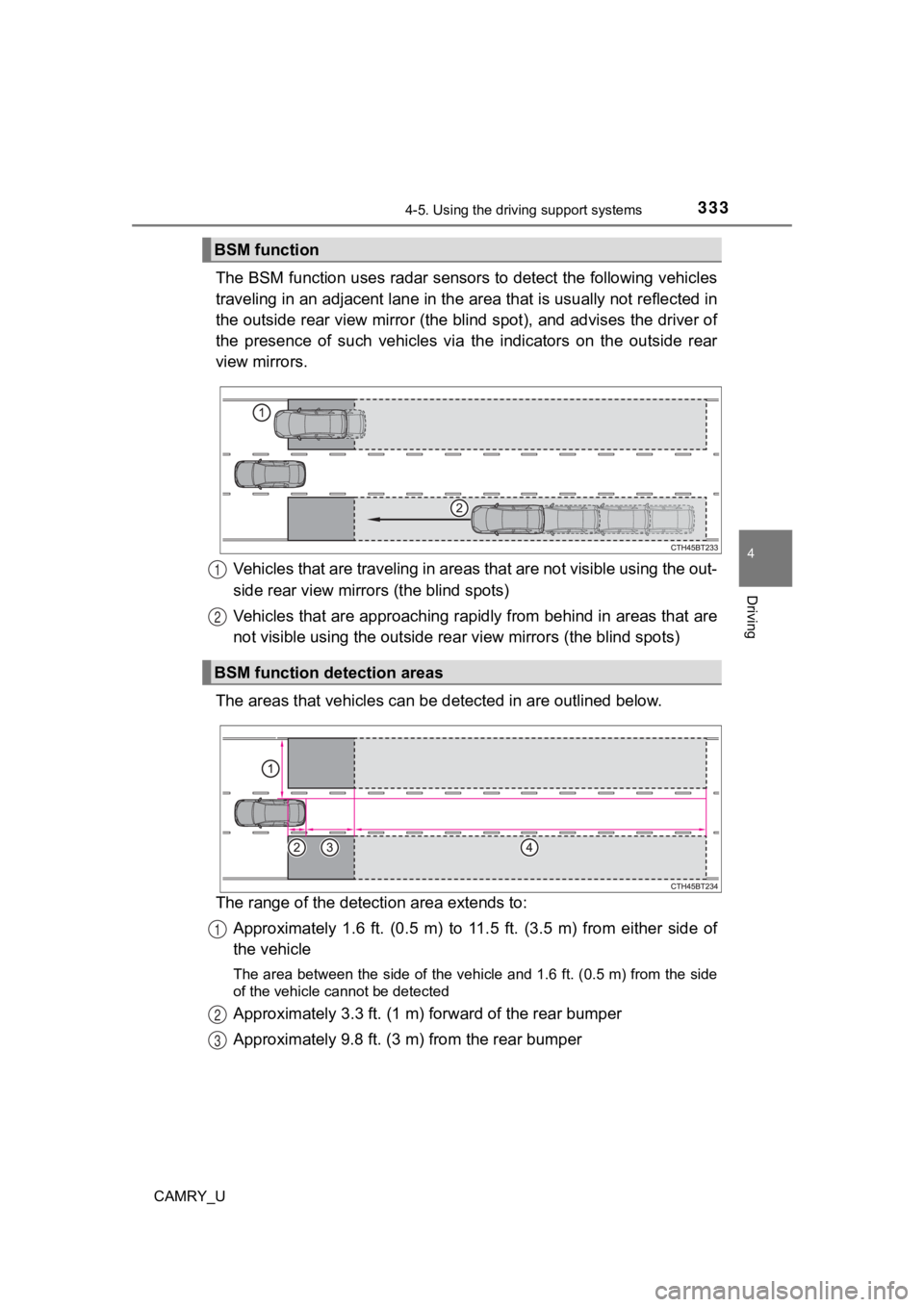
3334-5. Using the driving support systems
4
Driving
CAMRY_U
The BSM function uses radar sensors to detect the following vehicles
traveling in an adjacent lane in the area that is usually not r eflected in
the outside rear view mirror (the blind spot), and advises the driver of
the presence of such vehicles via the indicators on the outside rear
view mirrors.
Vehicles that are traveling in areas that are not visible using the out-
side rear view mirrors (the blind spots)
Vehicles that are approaching rapidly from behind in areas that are
not visible using the outside re ar view mirrors (the blind spots)
The areas that vehicles can be detected in are outlined below.
The range of the detecti on area extends to:
Approximately 1.6 ft. (0.5 m) to 11.5 ft. (3.5 m) from either s ide of
the vehicle
The area between the side of the vehicle and 1.6 ft. (0.5 m) fr om the side
of the vehicle cannot be detected
Approximately 3.3 ft. (1 m) f orward of the rear bumper
Approximately 9.8 ft. (3 m) from the rear bumper
BSM function
BSM function detection areas
1
2
1
2
3
Page 335 of 664

3354-5. Using the driving support systems
4
Driving
CAMRY_U■
Conditions under which the system may not function correctly
●The BSM function may not detect vehicles correctly in the following condi-
tions:
• When the sensor is misaligned due to a strong impact to the se nsor or its
surrounding area
• When driving on a road surface that is wet with standing water during bad
weather, such as heavy rain, snow, or fog
• When mud, snow, ice, a sticker, etc. is covering the sensor or surround-
ing area on the rear bumper
• When there is a significant difference in speed between your v ehicle and
the vehicle that enters the detection area
• When a vehicle is in the detection area from a stop and remains in the detection area as your vehicle accelerates
• When driving up or down consecutive steep inclines, such as hills, a dip
on the road, etc.
• When driving on roads with sharp bends, consecutive curves, or uneven
surfaces
• When multiple vehicles are approaching with only a small gap b etween
each vehicle
• When vehicle lanes are wide, or when driving on the edge of a lane, and
the vehicle in an adjacent lane is far away from your vehicle
• When the vehicle that enters the detection area is traveling a t about the
same speed as your vehicle
• When there is a significant difference in height between your vehicle and
the vehicle that enters the detection area
• Directly after the BSM function is turned on
● Instances of the BSM function unnecessarily detecting a vehicle and/or
object may increase under the following conditions:
• When the sensor is misaligned due to a strong impact to the se nsor or its
surrounding area
• When the distance between your vehicle and a guardrail, wall, etc. that
enters the detection area is short
• When there is only a short distance between your vehicle and a following
vehicle
• When vehicle lanes are narrow, or when driving on the edge of a lane, and a vehicle traveling in a lane other than the adjacent lanes enters the
detection area
• When items such as a bicycle carrier are installed on the rear of the vehi-
cle
• When driving up and down consecutive steep inclines, such as hills, dips on the road, etc.
• When driving on roads with sharp bends, consecutive curves, or uneven
surfaces
Page 336 of 664
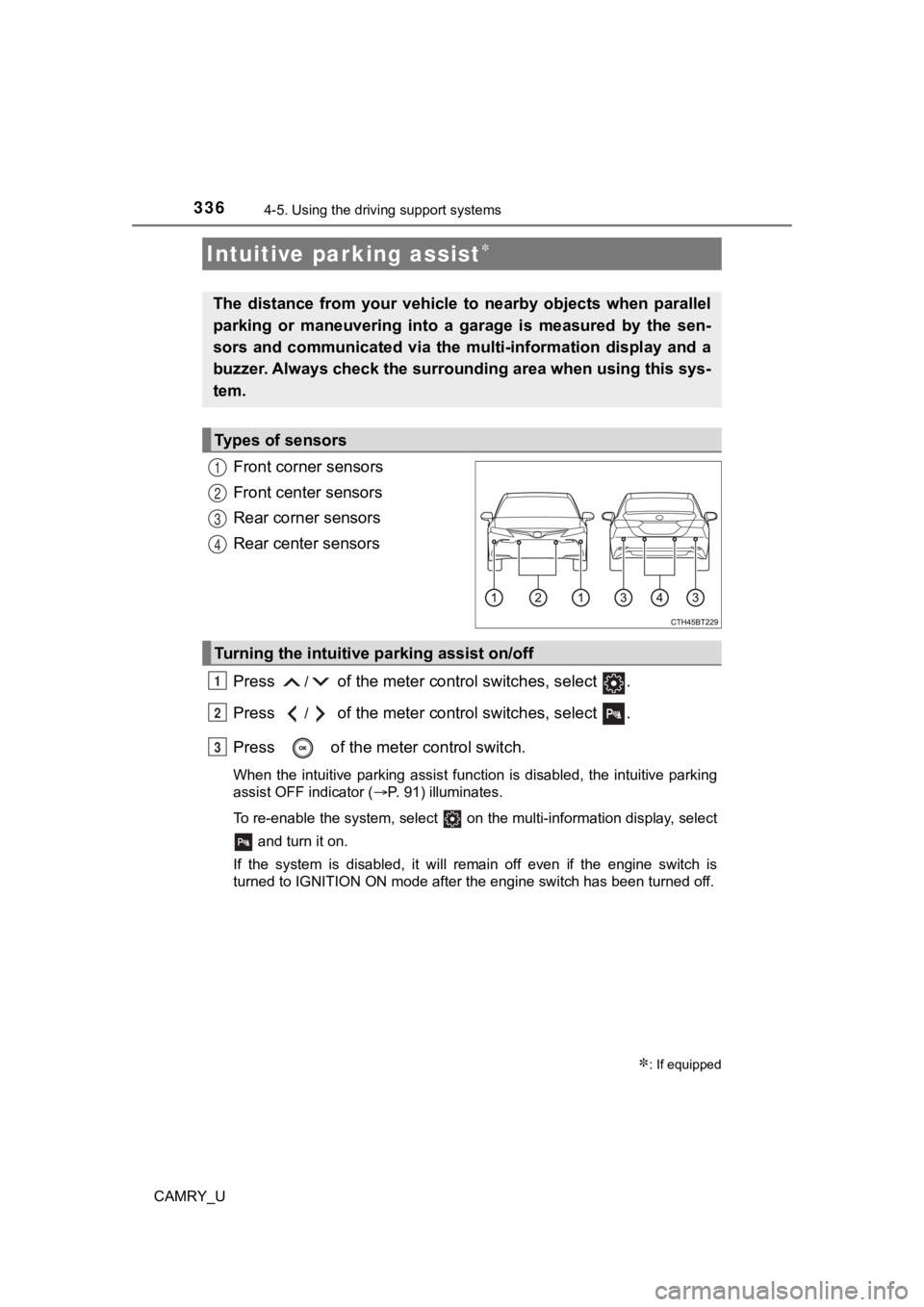
3364-5. Using the driving support systems
CAMRY_U
Front corner sensors
Front center sensors
Rear corner sensors
Rear center sensors
Press
/ of the meter control switches, select .
Press
/ of the meter control switches, select .
Press of the meter control switch.
When the intuitive parking assist function is disabled, the int uitive parking
assist OFF indicator ( P. 91) illuminates.
To re-enable the system, select on the multi-information display, select and turn it on.
If the system is disabled, it will remain off even if the engine switch is
turned to IGNITION ON mode after the engine switch has been turned off.
Intuitive parking assist
: If equipped
The distance from your vehicle to nearby objects when parallel
parking or maneuvering into a garage is measured by the sen-
sors and communicated via the multi-information display and a
buzzer. Always check the surro unding area when using this sys-
tem.
Types of sensors
1
2
3
4
Turning the intuitive parking assist on/off
1
2
3
Page 337 of 664
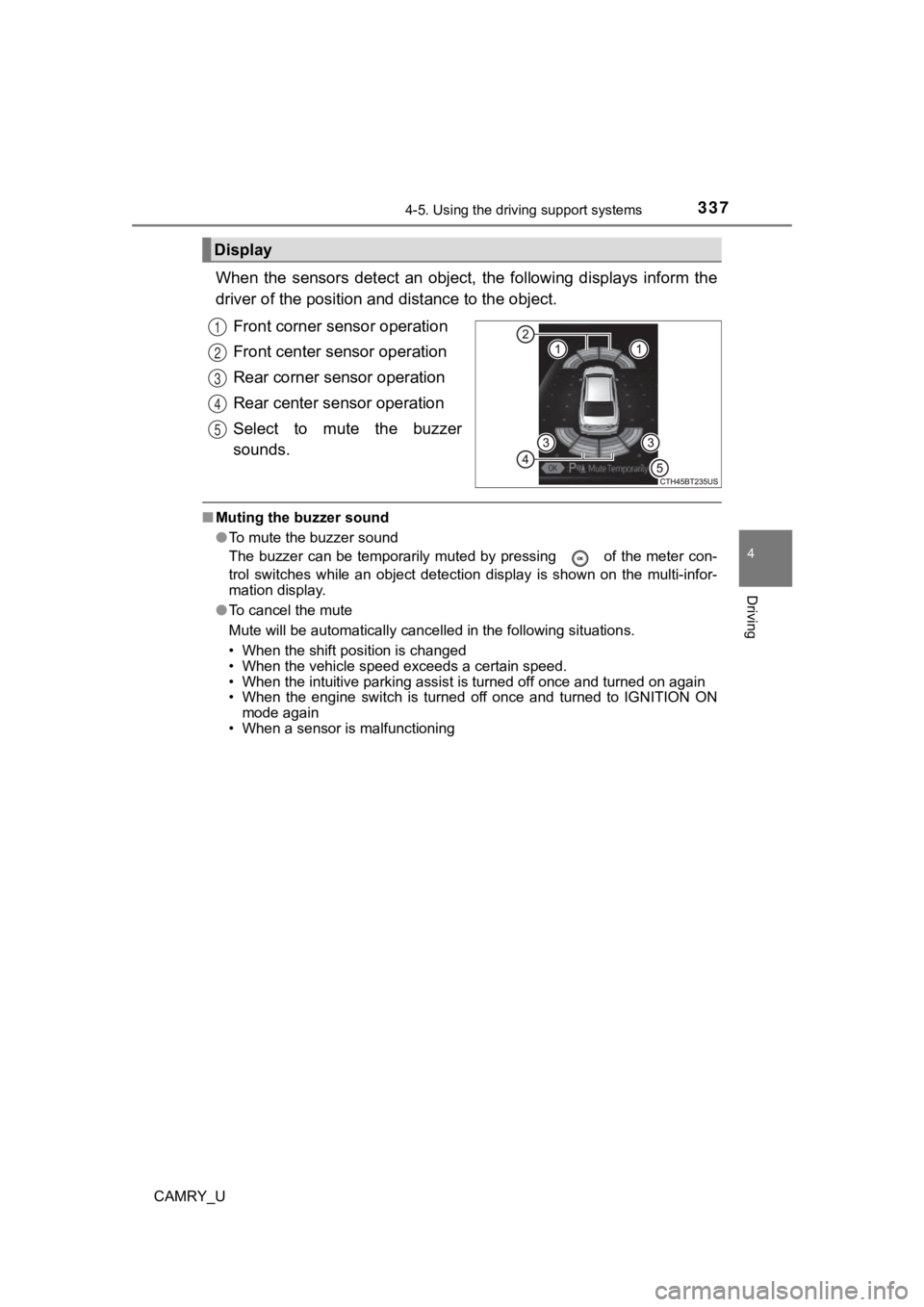
3374-5. Using the driving support systems
4
Driving
CAMRY_U
When the sensors detect an object, the following displays inform the
driver of the position a nd distance to the object.
Front corner sensor operation
Front center sensor operation
Rear corner sensor operation
Rear center sensor operation
Select to mute the buzzer
sounds.
■ Muting the buzzer sound
●To mute the buzzer sound
The buzzer can be temporarily muted by pressing of the meter c on-
trol switches while an object detection display is shown on the multi-infor-
mation display.
● To cancel the mute
Mute will be automatically cancelled in the following situation s.
• When the shift position is changed
• When the vehicle speed exceeds a certain speed.
• When the intuitive parking assist is turned off once and turned on again
• When the engine switch is turned off once and turned to IGNITI ON ON
mode again
• When a sensor is malfunctioning
Display
1
2
3
4
5
Page 338 of 664
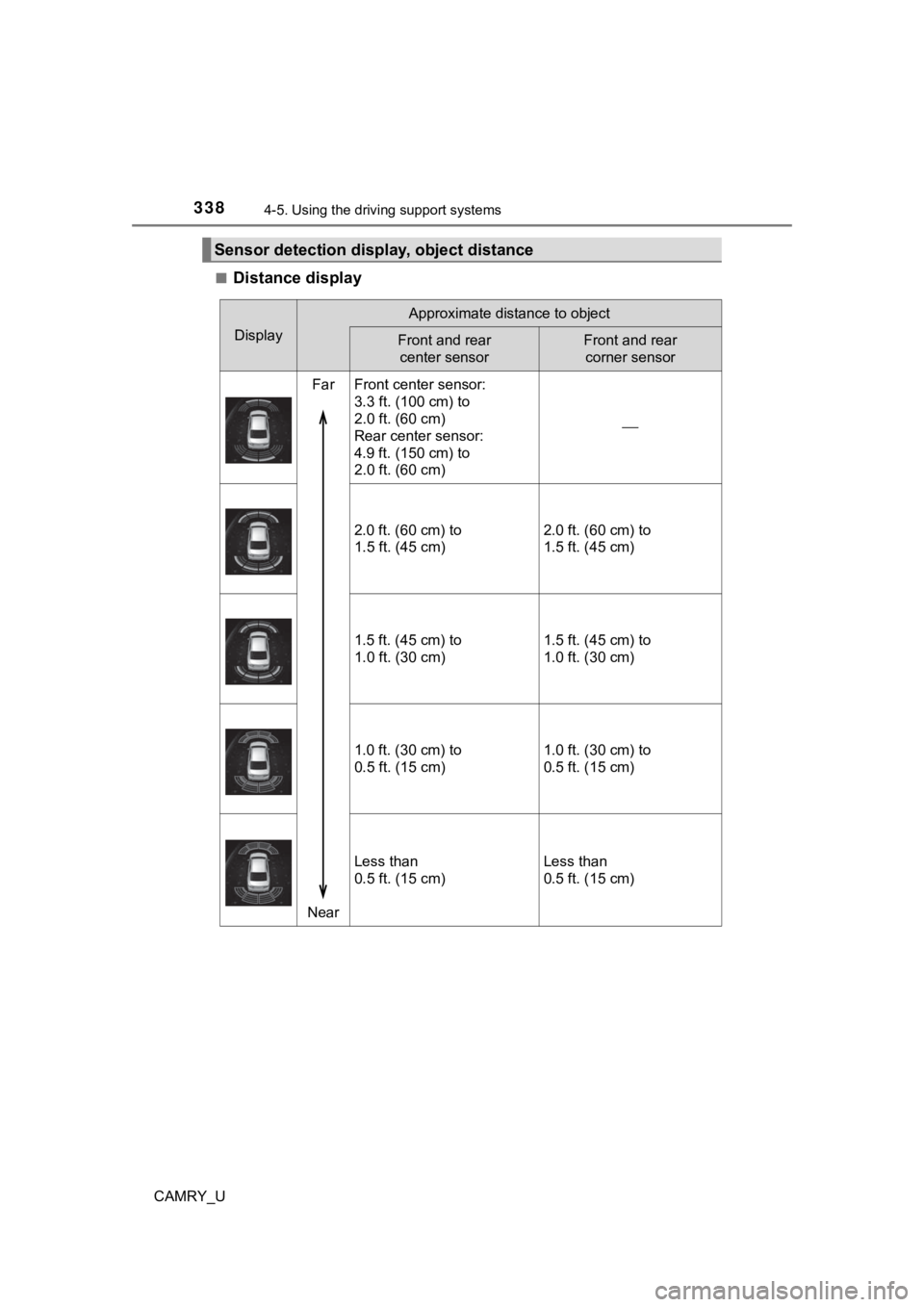
3384-5. Using the driving support systems
CAMRY_U■
Distance display
Sensor detection disp
lay, object distance
Display
Approximate distance to object
Front and rear
center sensorFront and rear corner sensor
Far
Near Front center sensor:
3.3 ft. (100 cm) to
2.0 ft. (60 cm)
Rear center sensor:
4.9 ft. (150 cm) to
2.0 ft. (60 cm)
2.0 ft. (60 cm) to
1.5 ft. (45 cm)2.0 ft. (60 cm) to
1.5 ft. (45 cm)
1.5 ft. (45 cm) to
1.0 ft. (30 cm)1.5 ft. (45 cm) to
1.0 ft. (30 cm)
1.0 ft. (30 cm) to
0.5 ft. (15 cm)1.0 ft. (30 cm) to
0.5 ft. (15 cm)
Less than
0.5 ft. (15 cm)Less than
0.5 ft. (15 cm)
Page 339 of 664
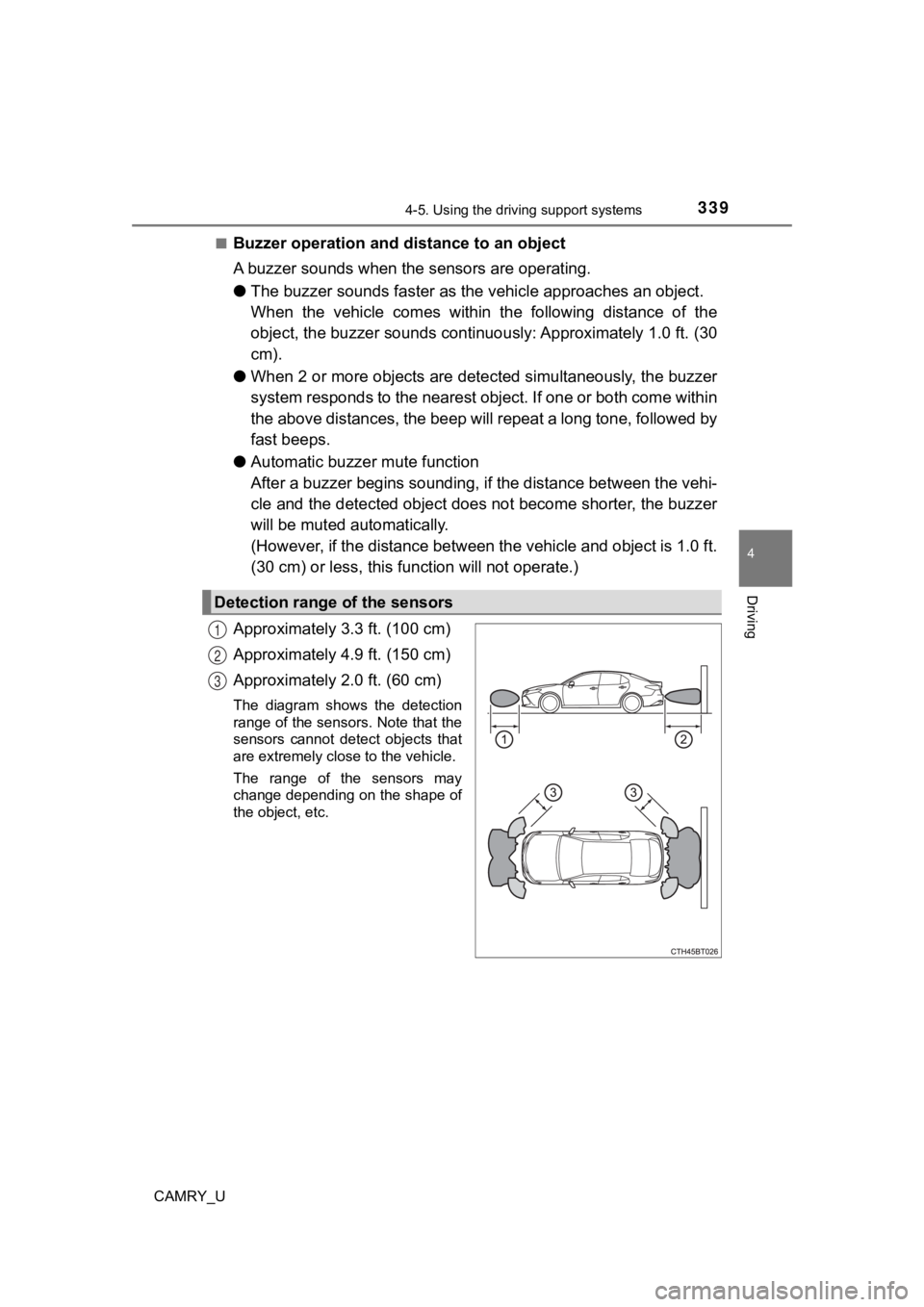
3394-5. Using the driving support systems
4
Driving
CAMRY_U■
Buzzer operation and
distance to an object
A buzzer sounds when the sensors are operating.
● The buzzer sounds faster as the vehicle approaches an object.
When the vehicle comes within the following distance of the
object, the buzzer sounds continuo usly: Approximately 1.0 ft. (30
cm).
● When 2 or more objects are detec ted simultaneously, the buzzer
system responds to the nearest object. If one or both come with in
the above distances, the beep will repeat a long tone, followed by
fast beeps.
● Automatic buzzer mute function
After a buzzer begins sounding, if the distance between the veh i-
cle and the detected object does not become shorter, the buzzer
will be muted automatically.
(However, if the distance between the vehicle and object is 1.0 ft.
(30 cm) or less, this function will not operate.)
Approximately 3.3 ft. (100 cm)
Approximately 4.9 ft. (150 cm)
Approximately 2.0 ft. (60 cm)
The diagram shows the detection
range of the sensors. Note that the
sensors cannot detect objects that
are extremely close to the vehicle.
The range of the sensors may
change depending on the shape of
the object, etc.
Detection range of the sensors
1
2
3
Page 340 of 664
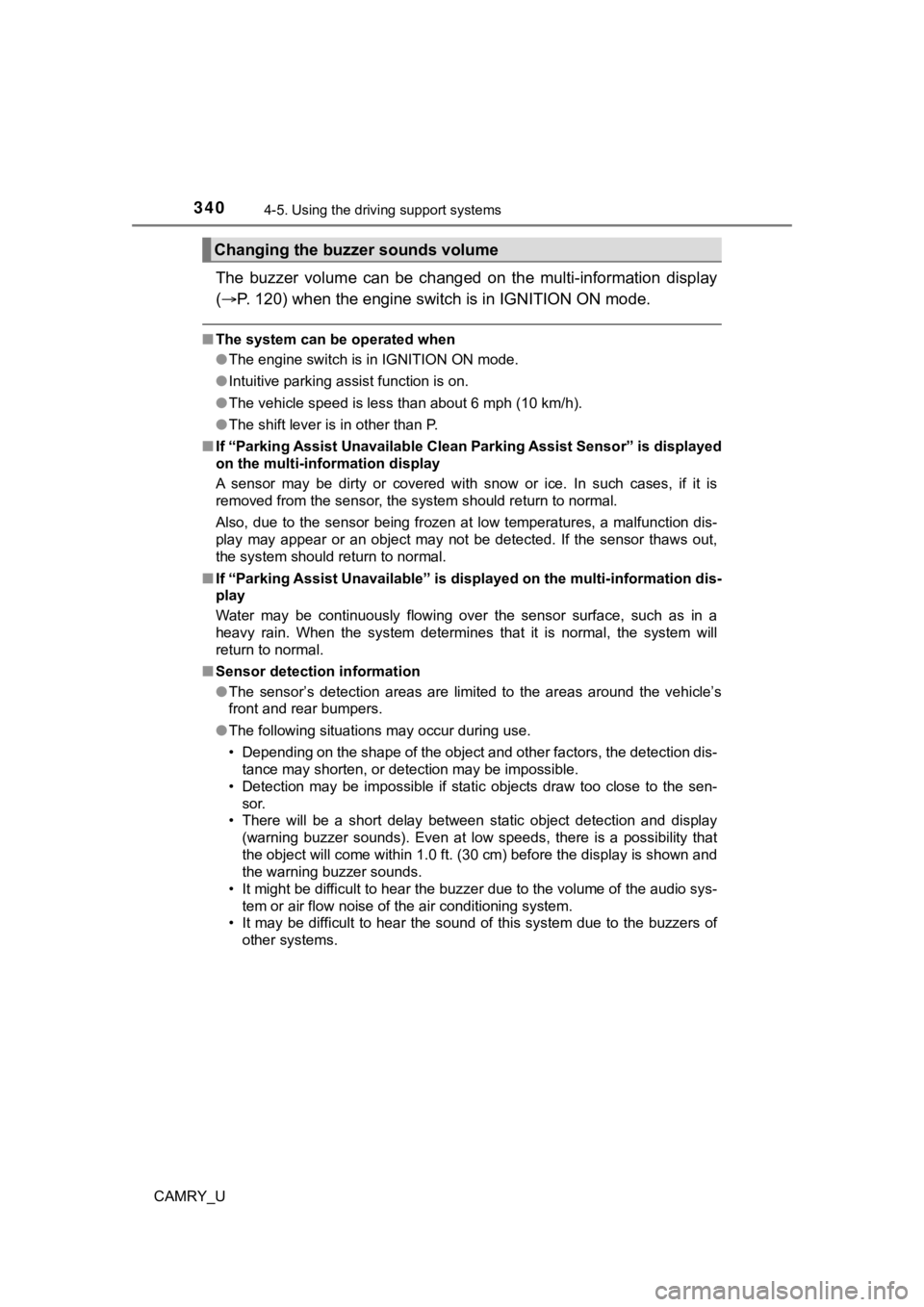
3404-5. Using the driving support systems
CAMRY_U
The buzzer volume can be changed on the multi-information display
( P. 120) when the engine switch is in IGNITION ON mode.
■The system can be operated when
●The engine switch is in IGNITION ON mode.
● Intuitive parking assist function is on.
● The vehicle speed is less than about 6 mph (10 km/h).
● The shift lever is in other than P.
■ If “Parking Assist Unavailable Clean Parking Assist Sensor” is displayed
on the multi-information display
A sensor may be dirty or covered with snow or ice. In such case s, if it is
removed from the sensor, the system should return to normal.
Also, due to the sensor being frozen at low temperatures, a mal function dis-
play may appear or an object may not be detected. If the sensor thaws out,
the system should return to normal.
■ If “Parking Assist Unavailable” is displayed on the multi-infor mation dis-
play
Water may be continuously flowing over the sensor surface, such as in a
heavy rain. When the system determines that it is normal, the system will
return to normal.
■ Sensor detection information
●The sensor’s detection areas are limited to the areas around th e vehicle’s
front and rear bumpers.
● The following situations may occur during use.
• Depending on the shape of the object and other factors, the de tection dis-
tance may shorten, or detection may be impossible.
• Detection may be impossible if static objects draw too close to the sen-
sor.
• There will be a short delay between static object detection an d display
(warning buzzer sounds). Even at low speeds, there is a possibi lity that
the object will come within 1.0 ft. (30 cm) before the display is shown and
the warning buzzer sounds.
• It might be difficult to hear the buzzer due to the volume of the audio sys-
tem or air flow noise of the air conditioning system.
• It may be difficult to hear the sound of this system due to the buzzers of
other systems.
Changing the buzzer sounds volume
Page 341 of 664
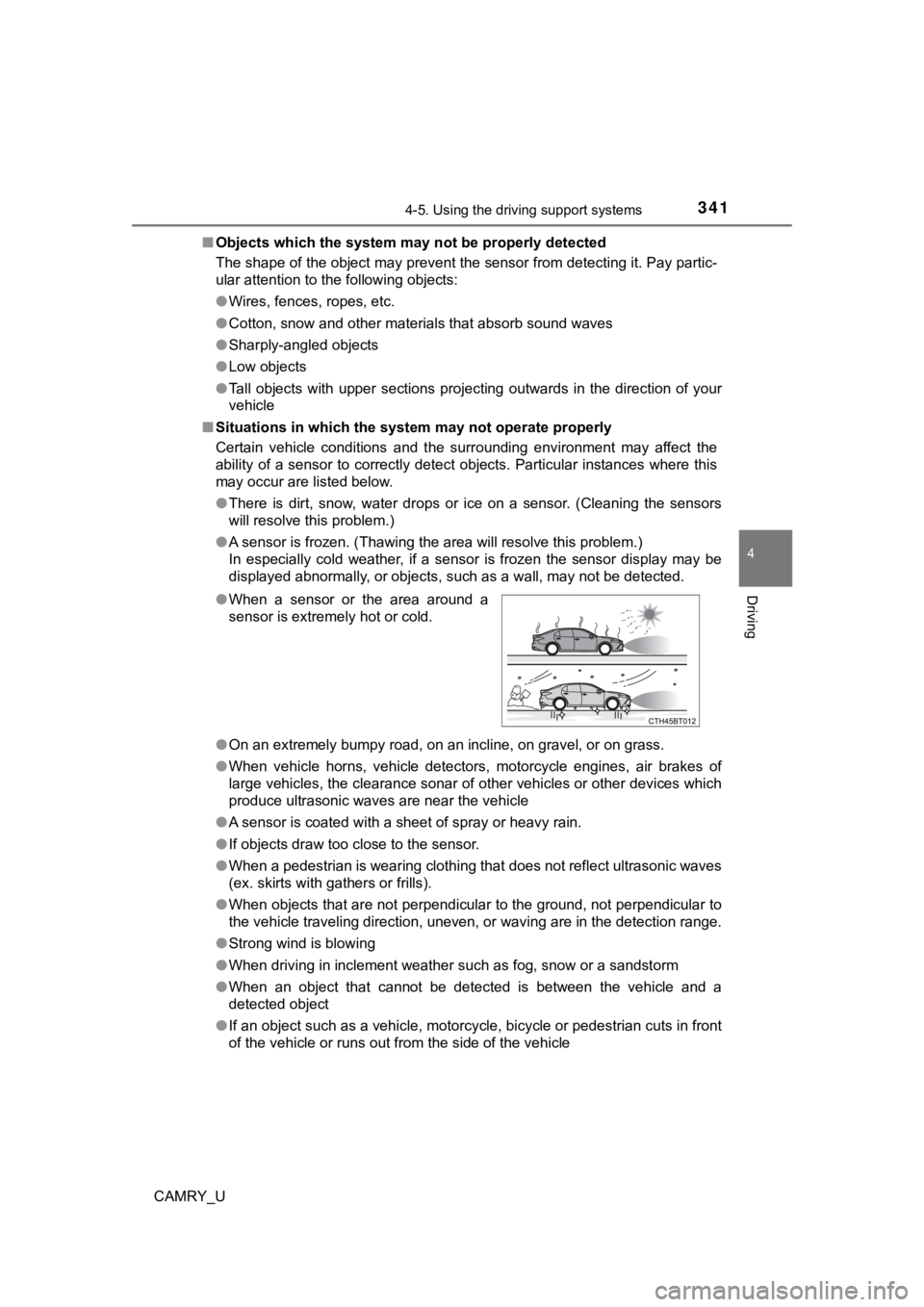
3414-5. Using the driving support systems
4
Driving
CAMRY_U■
Objects which the system may not be properly detected
The shape of the object may prevent the sensor from detecting it. Pay partic-
ular attention to the following objects:
●Wires, fences, ropes, etc.
● Cotton, snow and other materials that absorb sound waves
● Sharply-angled objects
● Low objects
● Tall objects with upper sections projecting outwards in the dir ection of your
vehicle
■ Situations in which the syst em may not operate properly
Certain vehicle conditions and the surrounding environment may affect the
ability of a sensor to correctly detect objects. Particular instances where this
may occur are listed below.
● There is dirt, snow, water drops or ice on a sensor. (Cleaning the sensors
will resolve this problem.)
● A sensor is frozen. (Thawing t he area will resolve this problem .)
In especially cold weather, if a sensor is frozen the sensor di splay may be
displayed abnormally, or objects, such as a wall, may not be detected.
● On an extremely bumpy road, on an incline, on gravel, or on grass.
● When vehicle horns, vehicle detectors, motorcycle engines, air brakes of
large vehicles, the clearance sonar of other vehicles or other devices which
produce ultrasonic waves are near the vehicle
● A sensor is coated with a sheet of spray or heavy rain.
● If objects draw too close to the sensor.
● When a pedestrian is wearing clothing that does not reflect ult rasonic waves
(ex. skirts with gathers or frills).
● When objects that are not perpendicular to the ground, not perpendicular to
the vehicle traveling direction, uneven, or waving are in the d etection range.
● Strong wind is blowing
● When driving in inclement weather such as fog, snow or a sandst orm
● When an object that cannot be detected is between the vehicle a nd a
detected object
● If an object such as a vehicle, motorcycle, bicycle or pedestrian cuts in front
of the vehicle or runs out from the side of the vehicle
●
When a sensor or the area around a
sensor is extremely hot or cold.
Page 342 of 664

3424-5. Using the driving support systems
CAMRY_U●
If the orientation of a sensor has been changed due to a collis ion or other
impact
● When equipment that may obstruct a sensor is installed, such as a towing
eyelet, bumper protector (an additional trim strip, etc.), bicy cle carrier, or
snow plow
● If the front of the vehicle is raised or lowered due to the car ried load
● If the vehicle cannot be driven in a stable manner, such as whe n the vehicle
has been in an accident or is malfunctioning
● When a tire chains or compact spare tire is used
■ Situations in which the system may operate even if there is no possibil-
ity of a collision
In some situations, such as the following, the system may opera te even
though there is no possibility of a collision.
● When driving toward a banner, flag, low-hanging branch or boom barrier
(such as those used at railroad crossings, toll gates and parking lots)
● When there is a rut or hole in the surface of the road
● When driving on a metal cover (grating), such as those used for drainage
ditches
● When driving up or down a steep slope
● If a sensor is hit by a large amount of water, such as when dri ving on a
flooded road
● There is dirt, snow, water drops or ice on a sensor. (Cleaning the sensors
will resolve this problem.)
● A sensor is coated with a sheet of spray or heavy rain
● When driving in inclement weather such as fog, snow or a sandst orm
● When vehicle horns, vehicle detectors, motorcycle engines, air brakes of
large vehicles, the clearance sonar of other vehicles or other devices which
produce ultrasonic waves are near the vehicle
●
When driving on a narrow road
●When strong winds are blowing